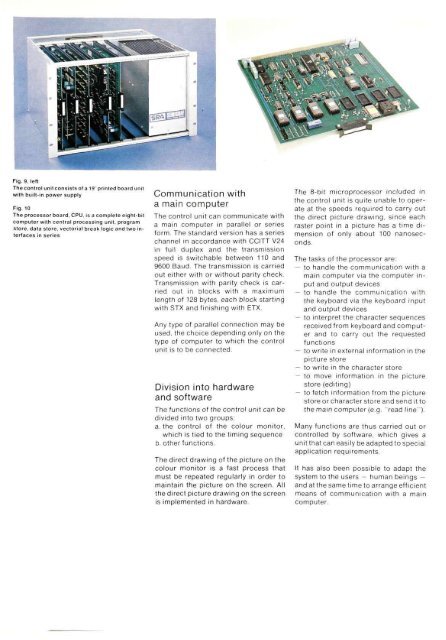Colour Display System SEMIGRAF 240 - The history of Ericsson
Colour Display System SEMIGRAF 240 - The history of Ericsson
Colour Display System SEMIGRAF 240 - The history of Ericsson
You also want an ePaper? Increase the reach of your titles
YUMPU automatically turns print PDFs into web optimized ePapers that Google loves.
Fig. 9, left<br />
<strong>The</strong> control unit consists <strong>of</strong> a 19 printed board unit<br />
with built-in power supply<br />
Fig. 10<br />
<strong>The</strong> processor board, CPU, is a complete eight-bit<br />
computer with central processing unit, program<br />
store, data store, vectorial break logic and two interfaces<br />
in series<br />
Communication with<br />
a main computer<br />
<strong>The</strong> control unit can communicate with<br />
a main computer in parallel or series<br />
form. <strong>The</strong> standard version has a series<br />
channel in accordance with CCITT V24<br />
in full duplex and the transmission<br />
speed is switchable between 110 and<br />
9600 Baud. <strong>The</strong> transmission is carried<br />
out either with or without parity check.<br />
Transmission with parity check is carried<br />
out in blocks with a maximum<br />
length <strong>of</strong> 128 bytes, each block starting<br />
with STX and finishing with ETX.<br />
Any type <strong>of</strong> parallel connection may be<br />
used, the choice depending only on the<br />
type <strong>of</strong> computer to which the control<br />
unit is to be connected.<br />
Division into hardware<br />
and s<strong>of</strong>tware<br />
<strong>The</strong> functions <strong>of</strong> the control unit can be<br />
divided into two groups:<br />
a. the control <strong>of</strong> the colour monitor,<br />
which is tied to the timing sequence<br />
b. other functions.<br />
<strong>The</strong> direct drawing <strong>of</strong> the picture on the<br />
colour monitor is a fast process that<br />
must be repeated regularly in order to<br />
maintain the picture on the screen. All<br />
the direct picture drawing on the screen<br />
is implemented in hardware.<br />
<strong>The</strong> 8-bit microprocessor included in<br />
the control unit is quite unable to operate<br />
at the speeds required to carry out<br />
the direct picture drawing, since each<br />
raster point in a picture has a time dimension<br />
<strong>of</strong> only about 100 nanoseconds.<br />
<strong>The</strong> tasks <strong>of</strong> the processor are:<br />
— to handle the communication with a<br />
main computer via the computer input<br />
and output devices<br />
— to handle the communication with<br />
the keyboard via the keyboard input<br />
and output devices<br />
— to interpret the character sequences<br />
received from keyboard and computer<br />
and to carry out the requested<br />
functions<br />
— to write in external information in the<br />
picture store<br />
— to write in the character store<br />
— to move information in the picture<br />
store (editing)<br />
— to fetch information from the picture<br />
store or character store and send it to<br />
the main computer (e.g. "read line").<br />
Many functions are thus carried out or<br />
controlled by s<strong>of</strong>tware, which gives a<br />
unit that can easily be adapted to special<br />
application requirements.<br />
It has also been possible to adapt the<br />
system to the users — human beings —<br />
and at the same timeto arrange efficient<br />
means <strong>of</strong> communication with a main<br />
computer.
















